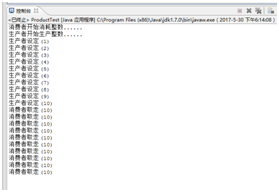(一)学习总结
1.用思维导图对java多线程的学习内容进行总结。

参考资料: XMind。
2.下面是一个单线程实现的龟兔赛跑游戏。
public class TortoiseHareRace {
public static void main(String[] args) {
int totalStep = 10;
int tortoiseStep = 0;
int hareStep = 0;
boolean[] flags = {true,false};
System.out.println("龟兔赛跑开始了...");
while(tortoiseStep < totalStep && hareStep < totalStep){
tortoiseStep++;
System.out.println("乌龟跑了"+tortoiseStep+"步...");
boolean isHareSleep = flags[((int)(Math.random()*10))%2];
if(isHareSleep){
System.out.println("兔子睡着了zzzz");
}else{
hareStep += 2;
System.out.println("兔子跑了"+hareStep+"步...");
}
}
}
}
阅读程序,采用实现Runnable接口的方式用多线程实现这个小游戏。下面给出主线程类,补充Tortoise线程类和Hare线程类。
public class TortoiseHareRace {
public static void main(String[] args) {
Tortoise tortoise = new Tortoise(10);
Hare hare = new Hare(10);
Thread tortoiseThread = new Thread(tortoise);
Thread hareThread = new Thread(hare);
tortoiseThread.start();
hareThread.start();
}
}
class Tortoise implements Runnable {
private int i;
private int tortoiseStep = 0;
public Tortoise(int i) {
this.i = i;
}
public void run() {
sai();
}
public void sai() {
try {
Thread.sleep(300);
} catch (InterruptedException e) {
e.printStackTrace();
}
while (tortoiseStep < i) {
tortoiseStep++;
System.out.println("乌龟跑了" + tortoiseStep + "步...");
}
}
}
class Hare implements Runnable {
private int i;
private int hareStep = 0;
public Hare(int i) {
this.i = i;
}
public void run() {
sai();
}
public void sai() {
try {
Thread.sleep(300);
} catch (InterruptedException e) {
e.printStackTrace();
}
boolean[] flags = { true, false };
while (hareStep < i) {
boolean isHareSleep = flags[((int) (Math.random() * 10)) % 2];
if (isHareSleep) {
System.out.println("兔子睡着了zzzz");
} else {
hareStep += 2;
System.out.println("兔子跑了" + hareStep + "步...");
}
}
}
}
3.下面的程序是模拟了生产者——消费者问题,生产者生产10个数,消费者依次消费10个数,运行程序,看结果是否正常?存在什么问题?说明原因。使用synchronized, wait, notify解决程序出现的问题。写出修改的部分程序即可。
class Consumer implements Runnable {
private Clerk clerk;
public Consumer(Clerk clerk) {
this.clerk = clerk;
}
public void run() {
System.out.println("消费者开始消耗整数......");
// 消耗10个整数
for(int i = 1; i <= 10; i++) {
try {
// 等待随机时间
Thread.sleep((int) (Math.random() * 3000));
}
catch(InterruptedException e) {
e.printStackTrace();
}
clerk.getProduct();// 从店员处取走整数
}
}
}
class Producer implements Runnable {
private Clerk clerk;
public Producer(Clerk clerk) {
this.clerk = clerk;
}
public void run() {
System.out.println( "生产者开始生产整数......");
// 生产1到10的整数
for(int product = 1; product <= 10; product++) {
try {
Thread.sleep((int) Math.random() * 3000);
}
catch(InterruptedException e) {
e.printStackTrace();
}
clerk.setProduct(product); // 将产品交给店员
}
}
}
public class ProductTest {
public static void main(String[] args) {
Clerk clerk = new Clerk();
Thread consumerThread = new Thread(new Consumer(clerk));
Thread producerThread = new Thread(new Producer(clerk));
consumerThread.start();
producerThread.start();
}
}
class Clerk {
private int product = -1; // -1 表示目前没有产品
// 这个方法由生产者呼叫
public void setProduct(int product) {
this.product = product;
System.out.printf("生产者设定 (%d)%n", this.product);
}
// 这个方法由消费者呼叫
public int getProduct() {
int p = this.product;
System.out.printf("消费者取走 (%d)%n", this.product);
return p;
}
}
运行结果:

修改:
class Clerk {
private int product = -1; // -1 表示目前没有产品
private int p ;
// 这个方法由生产者呼叫
public synchronized void setProduct(int product) {
if (this.product != -1) {
try {
super.wait();
} catch (InterruptedException e) {
e.printStackTrace();
}
}
this.product = product;
p= this.product;
System.out.printf("生产者设定 (%d)%n", this.product);
getProduct();
try {
Thread.sleep(300);
} catch (InterruptedException e) {
e.printStackTrace();
}
this.product = -1;
super.notify();
}
// 这个方法由消费者呼叫
public synchronized int getProduct() {
if (this.product == -1) {
try {
super.wait();
}catch (InterruptedException e) {
e.printStackTrace();
}
}
try {
Thread.sleep(300);
} catch (InterruptedException e) {
e.printStackTrace();
}
System.out.printf("消费者取走 (%d)%n", p);
this.product = -1;
super.notify();
return this.product;
}
}
wait()允许我们将线程置入“睡眠”状态,同时又“积极”地等待条件发生改变.而且只有在一个notify()或notifyAll()发生变化的时候,线程才会被唤醒,并检查条件是否有变。(只能在同步方法或者同步块里面调用wait()和notify())
4.其他需要总结的内容。
(二)实验总结
实验内容:
1.模拟三个老师同时分发80分作业,每个老师相当于一个线程。
完成实验内容,代码上传到码云,对完成实验内容过程中遇到的问题、解决方案和思考等进行归纳总结,注意代码中必须有必要的注释。
格式如下:
程序设计思路:首先要资源共享,所以要继承Runnable接口,在test类中每个老师作为一个线程调用start()。
类图结构:

2.模拟一个银行存款的程序。假设有两个储户都去银行往同一个账户进行存款,一次存100,每人存三次。要求储户每存一次钱,账户余额增加100,并在控制台输出当前账户的余额。
程序设计思路:因为是每人存3次,所以将次数常量放入run()方法里,在银行类里写入余额的计算方法。因为要资源共享,所以在用户类里要继承Runnable接口,在test类中每个老师作为一个线程调用start()。
类图结构:

问题1:运行结果中刚开始的账户余额本应该是100,但却是200
原因:我将money=money+100;放在了输出语句前面
解决方案:
System.out.println("账户总的金额是"+money);
money=money+100;
(三)代码托管(务必链接到你的项目)
https://git.oschina.net/hebau_cs15/java-cs01yangliu.git
码云commit历史截图
上传实验项目代码到码云,在码云项目中选择“统计-commits”,设置搜索时间段,搜索本周提交历史,并截图。
